Weighted cooperative spectrum sensing technology based on data fusion
This paper proposes a method using dynamic weighted cooperation and perception, and analyzes the performance of main users detected by cognitive users under different average signal-to-noise ratios. Simulation results show that weighted cooperative perception not only overcomes some deficiencies of current cooperative perception methods, but also has better detection performance than current cooperative perception methods.
Keywords: cognitive radio; weighted cooperative perception; energy detection; data fusion
With the growth of wireless communication services, the available frequency bands are becoming increasingly tight, especially in the range of hundreds of megahertz to 3GHz wireless bands where frequency requirements are very tight. In 1999, Dr. Joseph Mitola proposed the concept of cognitive radio (cogniTIve radio) [1]. Cognitive radio is an intelligent spectrum sharing technology, which can sense the characteristics of the surrounding environment and adopt a "build-understand" method to obtain from the surrounding Information, and adjust the transmission parameters (such as transmission power, operating frequency, coding method, etc.) in real time to adapt to changes in the environment, the basic requirement is not to cause interference to the main user.
Cognitive radio has three basic tasks: spectrum sensing, dynamic spectrum allocation, and transmit power control [2]. To avoid interference with primary users, spectrum sensing is considered a key technology in cognitive radio. Due to the influence of multipath fading and shadow effects, the detection reliability of single cognitive users is low, so cooperative spectrum sensing is proposed [3]. Cooperative spectrum sensing overcomes the effects of multipath fading and shadow effects, and can greatly improve the detection performance of primary users and spectrum holes. Although some cooperative spectrum sensing methods have been proposed at present, the research is mainly focused on data fusion with equal weights under the condition that individual cognitive users are independently and identically distributed and have the same average signal-to-noise ratio [4]. As a single cognitive user is distributed in different geographic locations and environments, the average signal-to-noise ratio will also be different. Each cognitive user ’s local decision will have a different impact on the global decision in the fusion center, and the current equal weight perception The algorithm does not consider the influence of these factors, so it is not optimal. Based on the above problems, this paper adopts a weighted cooperative spectrum sensing technology, which dynamically assigns different weights to each cognitive user according to the work of a single cognitive user under different signal-to-noise ratios. After the center is integrated, the center will make different weights to the judgments of each cognitive user, and then make judgments, which can improve the performance of spectrum sensing. Simulation results show that weighted cooperative spectrum sensing not only overcomes the shortcomings of current cooperative spectrum sensing methods, but also has better detection performance than current methods, which can greatly improve the detection probability of primary users and spectrum holes.
1 Single cognitive user detection model based on energy detection Single cognitive user perception usually uses matched filter detection, energy detection, and periodic stationary feature detection [5]. Since the energy detection algorithm is non-coherent detection, the requirements for phase synchronization are not high, the calculation complexity is low, the detection time is short, and the implementation is simple, so energy detection is adopted for a single cognitive user. The energy detection block diagram is given in Figure 1. The basic hypothesis model for detection can be described as: 

y (t) is the signal received by the cognitive user, x (t) is the signal transmitted by the primary user, n (t) is the additive white Gaussian noise, and h (t) is the gain of the channel. Under the assumption of H0, it means that no main user appears, and the assumption of H1 means that there is a main user.
In order to measure the energy of the received signal, the received main user signal x (t) is first passed through an ideal band-pass filter with a center frequency of fc and a bandwidth of W. Integrate and compare the output Y of the integrator with the threshold λ to detect the presence of the main user. The distribution of the test statistic Y is [6]: 
When the cognitive user is in a non-fading AWGN channel environment, the channel gain h (t) is determined, so the detection probability and false alarm probability of the primary user are expressed as [6]: 
Among them, λ is the threshold of energy detection;  It is a complete and incomplete Gamma function; Qm () is the universal Marcum Q function; as can be seen from the above formula, if Pd is very low, it will increase the interference to the main user; if Pf is too high, it will cause spectrum utilization low. When the cognitive user is in a fading environment, because Pf is independent of the signal-to-noise ratio, Pf remains unchanged. Since the channel gain h (t) varies, the detection probability is related to the instantaneous signal-to-noise ratio. The expression is:
It is a complete and incomplete Gamma function; Qm () is the universal Marcum Q function; as can be seen from the above formula, if Pd is very low, it will increase the interference to the main user; if Pf is too high, it will cause spectrum utilization low. When the cognitive user is in a fading environment, because Pf is independent of the signal-to-noise ratio, Pf remains unchanged. Since the channel gain h (t) varies, the detection probability is related to the instantaneous signal-to-noise ratio. The expression is: 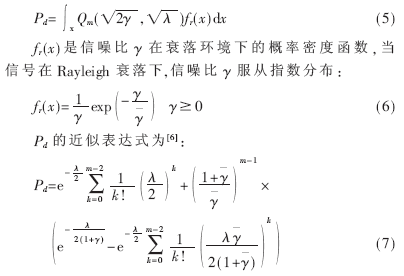
2 Cooperative Spectrum Sensing Figure 2 is a cognitive radio cooperative sensing structure diagram. Due to the influence of multipath fading and shadow effects, the reliability of single cognitive user detection is low. Cooperative sensing based on data fusion integrates information from cognitive users. To improve the detection performance of primary users and spectrum holes, each cognitive user makes local detection decisions u1, u2 ..., uN after processing the original data y1, y2 ..., yN from the primary user and then obtains them at the fusion center Global decision u0. Can greatly improve the detection probability of the main user. The current research on cooperative perception is mainly assuming that all cognitive users are independently and identically distributed and have the same average signal-to-noise ratio, usually using the "or" rule to perform data fusion with equal weights, that is, Wi = 1 (i = 1 , ... N). The detection probability and false alarm probability are expressed as Qd = 1- (1-Pd) N and Qf = 1- (1-Pf) N, Pd is given by formula (3) or (7), Pf is given by (4) The formula is given.
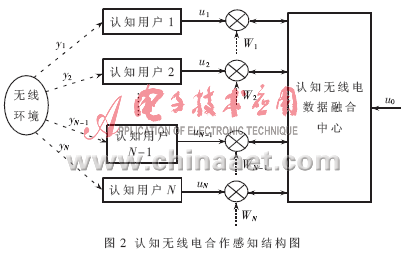
3 Weighted cooperative spectrum sensing In the actual working environment, due to the different geographical location and environment of each cognitive user and experiencing different fading environments, the average signal-to-noise ratio of each cognitive user is different. The effect on the global judgment is also different when data fusion is performed. At this time, if the traditional cooperative spectrum sensing method is used to detect the main user and the spectrum hole, the performance is not greatly improved, and sometimes it is even lower than the single user with better signal to noise in cooperative sensing. Detection.
For a single cognitive user working under different average signal-to-noise ratios, each cognitive user is dynamically given different weights. After the cognitive user sends the decision to the cognitive radio data fusion center, the center treats each cognitive user The decision is made after adding different weights. Compared with the traditional cooperative spectrum sensing method, the detection performance of the primary user can be greatly improved.
First, set the weight Wi (1) = 1 when all cognitive users perceive for the first time,
The ith cognitive user gets a weight Wi (n) after each perception (n≥2),
Wi (n) is the weight of the ith cognitive user in the nth perception, and the cognitive user will update the weight after each perception, the expression is [7]: 
Pd, i is the detection probability of the i-th cognitive user to the main user in the n-th perception process. The weight of each cognitive user changes with the perception process, but the sum of the weights keeps a constant value  . When a single cognitive user has a lower signal-to-noise ratio, the weight of the cognitive user will be reduced accordingly, so that when the cognitive radio data fusion center performs data fusion, the cognitive user's influence on the comprehensive judgment is also reduced. small.
. When a single cognitive user has a lower signal-to-noise ratio, the weight of the cognitive user will be reduced accordingly, so that when the cognitive radio data fusion center performs data fusion, the cognitive user's influence on the comprehensive judgment is also reduced. small.
In the data fusion center, the main user is comprehensively judged according to the weight of each cognitive user. The false alarm probability is not weighted because it is independent of the signal-to-noise ratio, so the detection probability [8] and false alarm probability of the primary user based on weighted cooperative spectrum sensing are: 

4 Simulation and analysis of results In the experiments, the detection performance of traditional cooperative spectrum sensing and weighted cooperative spectrum sensing were compared in AWGN channel non-fading and Rayleigh fading environments. Take the parameter m = 2. As shown in Figure 3, in the non-fading environment of the AWGN channel, the number of cognitive users used for cooperative sensing is 4, and 4 different signal-to-noise ratios are randomly selected from 1dB to 7dB and assigned to 4 different cognitive users The signal-to-noise ratio of a single cognitive user is 7dB. As can be seen from the figure, the performance of the traditional equal-weight cooperative sensing method is sometimes even lower than that of a single cognitive user with a high signal-to-noise ratio. After adopting weighted cooperative sensing, the sensing performance of the second and third times is significantly improved. When Pf is less than 0.1, after the third sensing, the detection probability Pd can be close to 1.
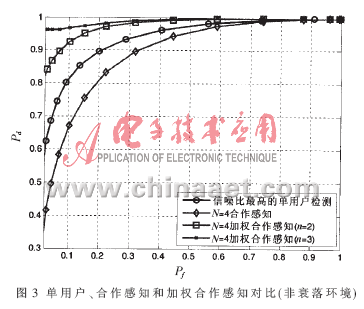
In Figure 4, under the Rayleigh fading environment, 4 different signal-to-noise ratios are randomly selected from 1dB to 7dB to be given to different cognitive users. The detection performance of traditional cooperative perception is better than single-noise. User detection performance is not much different. After the second perception, the performance of weighted cooperative perception is better than the traditional cooperative perception and single-user detection with high signal-to-noise ratio. The third weighted cooperative perception performance is better than the second perception performance.
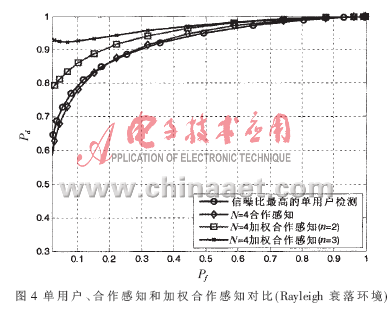
In Fig. 5, under the non-fading environment of AWGN channel, the traditional cooperative perception and weighted cooperative perception are compared under the situation that the number of cognitive users is 4 and 6 respectively, and it can be seen that the number of the same cognitive users Under the second, the detection performance of weighted cooperative perception after the second perception is better than traditional cooperative perception, and the performance of weighted cooperative perception also increases with the increase of the number of cognitive users. Figure 6 is a comparison of two sensing methods in a Rayleigh fading environment. Similarly, the detection performance of the weighted cooperative perception for the primary user is better than the traditional cooperative perception. Therefore, the use of weighted cooperative spectrum sensing not only overcomes the shortcomings of current cooperative spectrum sensing, but also greatly improves the detection probability of primary users in both fading and non-fading environments.
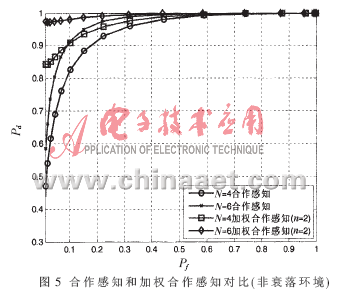
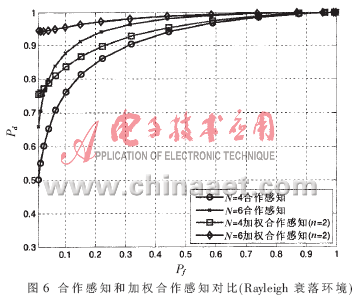
The weighted cooperative spectrum sensing performance of cognitive radio in the AWGN channel non-fading and Rayleigh fading environment is analyzed. At the same time, the weighted cooperative spectrum sensing is compared with the current cooperative sensing method, and a dynamic weighted cooperative sensing method is proposed. The performance of main users detected by cognitive users under different average signal-to-noise ratios is analyzed. However, cognitive radio works in a complex and changing environment. Although cooperative spectrum sensing can detect the main user more accurately, in a resource-constrained network, it may be considered to transmit only those recognitions with better detection performance in certain situations. Knowing the user's decision result can reduce the probability of misjudgment of the primary user, improve the detection performance, and make better use of the primary user's idle spectrum.
references
[1] MITOLA J. CogniTIve radian integrated agent architecture for software defined radio [D]. Ph.D Thesis, KTH Royal InsTItute of Technology Sweden, 2000.
[2] HAYKIN S. CogniTIve radi brain-empowered wireless communication [J]. IEEE JSAC, 2005,23 (2): 201-220.
[3] GANESAN G, LI Y G. Cooperative spectrum sensing in cognitive radio networks [C]. In Proc. IEEE DySPAN 2005,2005: 137-143.
[4] GHASEMI, SOUS E S. Collaborative spectrum sensing for opportunistic access in fading environment [C]. In Proc. IEEE DySPAN 2005, 2005: 131-136.
[5] CABROC D, MISRRA SM, BRODERSEN R W. Implementation issues in spectrum sensing for cognitive radios [C]. In Proc. 38th Asilomar Conference on Signals. Systems and Computers 2004,2004: 772-776.
[6] DIGHAM F, ALOUINI M, SIMON M. On the energy detection of unknown signals over fading channels [C]. In Proc.IEEE ICC 2005,5: 3575-3579.
[7] HUANG Xiao Ge, HAN Ning, ZHENG Guan Bo, et al. Weighted-Collaborative spectrum sensing in cognitive
radio [C] .Chinacom 2007, Shanghai, China, August, 2007.
[8] LEE J, KIM YOUNG Min. Weighted-cooperative spectrum sensing scheme using clustering in cognitive radio systems [C]. IEEE ICACT 2008,2008: 786-790.
Shenzhen Dianjiang Engineering Co. LTD , https://www.isourceled.com